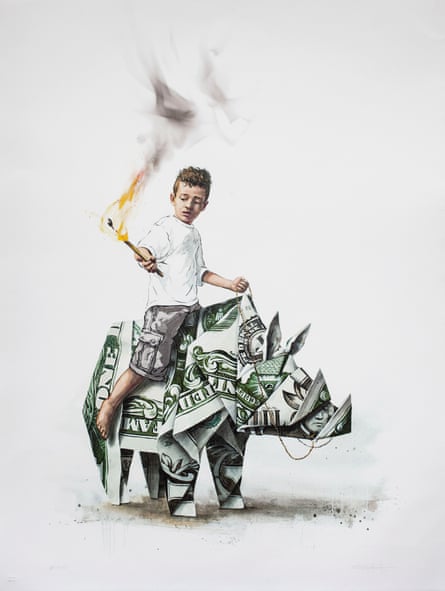Dramatically carved into the landscape of a Sumatran oil palm plantation that borders one of the world’s most unique rainforests are three ominous letters: SOS.
The message stretches half a kilometre alongside a snaking river; a bird’s-eye view gives the eerie sense the land has been given voice, and is issuing a mayday.
“From the ground, you would not suspect anything more than just another palm oil plantation. The aerial view, however, reveals the SOS distress signal,” says the Lithuanian artist Ernest Zacharevic.
For a week Zacharevic has been carefully plotting his concept out tree by tree – or oil palm by oil palm – all 1,100 that were cut down to etch out the message.
The work in Bukit Mas, Sumatra, is intended to convey a pressing distress signal, drawing attention to the ongoing destruction of Indonesia’s rainforests and the critically endangered species, such as the Sumatran orangutan, that reside within it.
“Save Our Souls is a message communicated to those at a distance, a reminder of the connectedness we share with nature,” he says of the acronym. “As more of the forests are lost, we lose a little bit of ourselves in the process.”
This is the second year running that Zacharevic, a multidisciplinary artist famed for his Penang murals, has taken the state of Indonesian forests to heart in an artistic awareness campaign called Splash and Burn.
The campaign is a play on the “slash and burn” technique used by some Indonesian farmers to clear swaths of rainforest for oil palm plantations.
Indonesia is the world’s largest producer of palm oil – a substance widely used in food, cosmetics and cleaning products – and as the country’s rainforests shrink, the industry stands accused of complicity in mass deforestation.
Inspired initially by the devastating forest fires of 2015, Zacharevic says this year he has delved deeper into the industry’s problems, as well as artistic ways to express them.

“Last year I said if we ever come across a huge piece of plantation it would be very fun to carve an artwork into it. Even a simple piece could speak very loudly,” he explains. “And things just fell into place a few weeks ago.”
Armed with ribbons, a drone and a chainsaw-wielding crew, Zacharevic and his team laboured over five days to carve the message into an area spanning 20 hectares.
But it wasn’t until one of the final days when the clouds cleared that they were certain they had pulled it off.
“We lived in the village so we would rise with the locals and it was very beautiful and sunny,” he recalls. “We launched our drone and we get this sharp, direct sunlight, the morning light, and it was so sharp and vivid. We all screamed, “It works, it works!”
This year the artist has collaborated with the Sumatran Orangutan Society (SOS), which, together with the cosmetics company Lush, raised the funds to buy the 50-hectare (124-acre) oil palm plantation with the intention of reforesting it entirely.
Before the oil palms are replaced with tens of thousands of native seedlings, Zacharevic was offered the chance to bring his idea to life.
SOS’s director, Helen Buckland, was on site as the art project was under way and cheered as the oil palms were felled.
“Mostly conservationists when they hear a chainsaw near a forest get a bit of a shudder down their spine, but this time it was a very positive experience,” says Buckland. “As we went across on a raft I could already hear the chainsaws and it was exciting because I knew they were clearing the land for two reasons: for Ernest’s creation of his artwork, but also reclaiming it for this new restoration site.”
Funds for the site were raised in part through the sale of 14,600 orangutan-shaped soaps, produced by Lush last year – one for every critically endangered Sumatran orangutan left in the wild.
The land is now owned by SOS’s Indonesian sister organisation, the Orangutan Information Centre (OIC), and will link up to an existing OIC restoration site that borders the Leuser ecosystem, the last place on earth where orangutans, rhinos, tigers and elephants coexist.
In about four years the former plantation will have a well-established young forest structure, says Buckland, with trees up to six metres high.
“It is really special to be able to go back to a restoration site and stand under the shade of a tree that was only planted a couple of years ago and hear birdsong,” she says.
The reforested area will also create a buffer zone for the protected forest as well as new habitats for orangutans and other species.
Zacharevic says he hopes the work can cut through the distractions and start a much-needed dialogue.
“From my perspective it was bringing in a bit of social media culture,” he says of the concept. “I think a lot of us are very immersed and distracted by false values so I thought about putting up a distress signal, where people’s attention should be.”

Comments (…)
Sign in or create your Guardian account to join the discussion